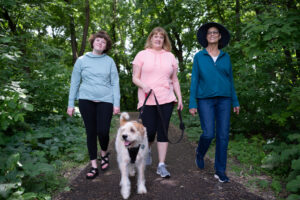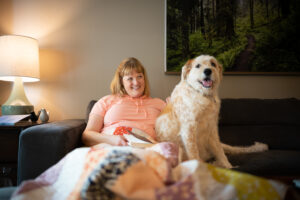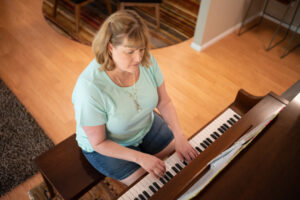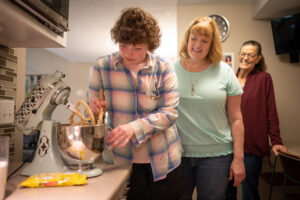Tracy | Living with ARVC
Minneapolis, Minnesota | Born June 1977
With this disease, no rules apply to us. Up is down. Right is left. A lot of the time there is just no rhyme or reason.
Eddie can hardly contain his excitement as he runs back and forth sniffing the air with gusto. He loves trips to the park and relishes in the array of animal smells, tugging on his leash with enthusiasm. Tracy firmly holds the other end, flanked by Ava, her daughter, and Diane, her mother, all following the dog’s erratic path.
Three generations walk side by side, grateful to still be able to spend time together, and to enjoy a warm summer day in the Upper Midwest. Tracy’s family has deep roots here. She grew up in the Red River Valley that straddles the border between Minnesota and North Dakota—a region known for its agricultural riches. Her grandparents were farmers, and she holds fond memories of what it was like to visit them as a girl. However, now much of her family lives in greater Minneapolis—a gradual transition—in large part to maintain access to better medical care.

Stopping to rest frequently, Tracy paces herself as she walks. Even the mild hills on this parkland can cause her serious fatigue and she cannot push it. This difficulty is part of the reality of living with arrhythmogenic right ventricular cardiomyopathy (ARVC), a genetic heart disease caused by a malformation of cardiac muscle tissue that can result in dangerous arrhythmias and heart failure—all of which Tracy suffers from. Because of this, her heart has to work harder to properly circulate blood throughout her body, and pushing herself too hard could result in a frightening cardiac episode.
This is something that Diane understands all too well. “She knows the stuff I’ve been through,” she relays in a charming Minnesotan accent. “She knows what I’ve dealt with.” Tracy’s mother also lived with ARVC until, in 2016, she got a heart transplant—the only feasible course of treatment. “I was very lucky,” she continues. Her new heart has served her well, and she has experienced no acute rejection. “I feel like things could not have gone better.”
With Diane’s new heart, she now has the restored energy to help Tracy as she heads down a similar path. “She is my most empathetic supporter,” says Tracy. “She’s not only my mom, but she knows all the challenges that come with a transplant.” Additionally, Diane regularly helps with fixing up the townhome where Tracy and Ava live—things like redoing the bathroom, painting, and working in the yard. “She knows I’m sick and this is what she can do to help me at this point, as I wait for my heart.”
While for others in her family, ARVC manifested through abrupt and frightening episodes of arrhythmia, Tracy’s problems have been more related to heart failure. It has advanced considerably as she has aged, forcing her to change her lifestyle, give up her career, and to patiently wait for an inevitable transplant.
For Ava this fact holds little comfort. “I am nervous about the next time my mom goes in for testing,” the teenager says, concerned. This winter, Tracy will go into the hospital again to be evaluated for transplant. “It means she won’t be home for Christmas,” Ava laments. In lab tests, Tracy has shown a high panel-reactive antibody count meaning that she will need a very precise donor match in order to avoid acute rejection, something that can take years to find.
Ava, who is entering adolescence, also inherited ARVC and is already exhibiting signs of the disease. As unfortunate as this is, her early entry to the universe of cardiac health gives her an advantage, along with hope for different outcomes down the road. It is already quite clear that her journey with ARVC will be much different than previous generations.
To date, Tracy is aware of five members of her family who were diagnosed with or were thought to have ARVC. “In our family each person has such a different progression with the same disease, the same gene,” says Tracy. “With this disease, no rules apply to us. Up is down. Right is left. A lot of the time there is just no rhyme or reason.” As she has learned, ARVC is a highly variable disease, with very different presentations and problems in each person.

When Tracy was 11 years old, her grandfather died of cardiac arrest in his sleep. “It was a surprise,” she says. “He was in his 60s. He never smoked. He didn’t drink. He was a healthy farmer in North Dakota.” It was the first loss in her young life, and there was no inkling that anything genetic might be going on and that someday, she would face similar hurdles.
Tracy was a tall kid, towering over many of her peers. While this made her feel awkward at times, she had no problem getting onto youth sports teams. Along with her two sisters, she excelled at athletics, specifically basketball and swimming, holding spots on multiple teams in high school.
At 16 years old, Tracy had her first symptom of then-unknown ARVC. While standing in her kitchen one afternoon, she suddenly felt sick. Deciding to go lie down, she ascended the stairs towards her room and suddenly became very nauseous. She turned to go to the bathroom and became instantly paralyzed and fell over. “I didn’t black out, but I couldn’t move. I couldn’t talk.” She lay frozen for a minute on the floor. Her vision blurred and sounds became more distant. A moment later, she came to.
“I now know that was definitely VT,” explains Tracy. VT or ventricular tachycardia is an arrhythmia caused by faulty electrical signals in the heart that can lead to sudden cardiac arrest. But at the time, Tracy’s doctor surmised that she simply had low blood sugar.
Tracy would go years without other episodes of VT, but her older sister, Sunny, would not be so lucky. In 1996, Sunny was admitted to the hospital with a heart rate over 200 bpm, at least double a normal resting heart rate of 60-100 bpm. She lived in Rochester, MN at the time, home to Mayo Clinic. She went there for further imaging and tests, which eventually gave cardiologists enough evidence to diagnose her with ARVC. She was the first in Tracy’s family to have the diagnosis and received an implantable cardioverter defibrillator (ICD) to protect her against arrhythmias and sudden cardiac arrest.
Around that time while in her junior year at college, Tracy would have her second episode. Early in the morning, on her way to the bathroom, she suddenly lost consciousness. “When I woke up, I didn’t know where I was.” With her sister’s recent diagnosis, and the potential risks posed by ARVC, Diane urged her to see an electrophysiologist.

“The quality of care in your treatment is so dependent on who you get hooked up with,” Tracy attests. She got an appointment at the University of Minnesota hospital, conveniently located across the street from where she lived at the time. Furthermore, her electrophysiologist, a specialist in treating arrhythmias, happened to work on ARVC research, and knew the condition well. “That was the biggest blessing in all of this.” At the time, the issues in Tracy’s heart appeared to be taking place specifically on the left side, and so for the time being, diseases of the right ventricle, such as ARVC, were off the table.
Tracy continued to pursue her goals despite the looming heart troubles. In 2002, she began graduate school for academic advising, something she was passionate about. Around that same time her mother, Diane, also faced symptoms from still-undiagnosed ARVC. “I passed out in a step aerobics class,” Diane says. “They told me to get checked out before I came back.” Her doctors in Fargo didn’t see anything wrong, but on Tracy’s urging, she went to see the electrophysiologist who Tracy had seen in Minneapolis. “A few years before, my EKG was normal,” relays Diane. “But this time it was not.”
Imaging and testing led Diane to eventually get diagnosed with ARVC in 2003, adding to the familial picture of the disease. Furthermore, she learned that she was in heart failure, due to the damage slowly accumulated from the condition.
In 2004, after getting married, Tracy decided to go back to the electrophysiologist for follow-up tests, as it had been a few years. Given the recent diagnoses, the doctor was keen to test more thoroughly for ARVC. However, there was other shocking news. “The doctor told me I had heart failure,” recalls Tracy. “I was crushed. I didn’t realize I was having symptoms. I didn’t even know I was that sick.” The slow onset of her heart failure hid the changes in Tracy’s body—the lack of energy she was experiencing felt “normal.” She was prescribed beta blockers and an ACE inhibitor until further testing could be done.
Tracy was formally diagnosed with ARVC in February of 2005 and had an ICD placed. “The diagnosis was a bit of a relief,” she remembers. Getting the ICD meant extra protection, and with that, Tracy was convinced not to let the disease slow her down. Along with her then-husband, she moved to Newport News, Virginia.
A few years later Tracy became pregnant with Ava, which for her signaled a major life change—not only with an addition to her family, but sadly, in the trajectory of her heart failure. The added stress of pregnancy pushed her into freefall. Her energy and abilities steadily declined and at six months pregnant, her ICD shocked her out of an arrhythmia. The first and only shock Tracy ever experienced from her device.
Ava was born without incident, but Tracy’s heart function continued to decline. She visited a heart failure specialist who wanted to list her for transplant right then and there. She also made her first visit to John Hopkins Hospital, where she learned more important information about managing ARVC, particularly that she should avoid any hard exercise. Changes needed to be made quickly or she would need to go on the transplant list very soon.
Determined to get the best care possible and avoid a transplant, she left her new life in Virginia, and returned to Minneapolis to see her most trusted cardiac doctors. “They pulled me back from the ledge,” she recalls. With close monitoring, and fine-tuning of medications, her heart would remain stable for the next decade.

Music fills Tracy and Ava’s home. Back inside, out of the summer heat, Tracy sits at the piano, her fingers finding the rhythms and chords to her favorite songs from over the years. It is also a needed foray into creativity. This creativity can be found throughout her house: in her kitchen where she loves to cook, in the dining room where she works on jewelry and quilting projects, and in her living room where she indulges in books and TV.
Across the room, Ava listens to her mother playing. She has gleaned musical knowledge from Tracy, but as is her hallmark, went her own path, learning the trombone instead. She has a good ear and loves to practice, although she feels self-conscious about disturbing the neighbors. Her creative energy is boundless, a result, in some sense, of living with ARVC.
Ava’s road to diagnosis was very different from previous generations. When she was one, Tracy decided to do genetic tests which uncovered a mutation to the PKP2 gene, which is responsible for the formation of cardiac muscle tissue. This is the gene variation (mutation) that has been passed down through generations of their family and is one of the most common gene variations associated with ARVC.
At 10 years old, imaging revealed changes to Ava’s cardiac muscle structure, and she was officially diagnosed with ARVC. “It wasn’t anything groundbreaking,” Ava recalls casually. “I always thought I’d have it.” It would take a more courageous attitude to go in for her first surgery—to place an ICD—about a year later.
Ava’s official diagnosis was devastating for Tracy. It confirmed her worst fears. However, Tracy had been managing ARVC for years, and knew that the only way to deal with the news was Tracto set Ava on the right course from the start. “Knowledge is power with this disease,” she says. “We can protect her.”
In response, Tracy helped build a world for Ava with different expectations. “I didn’t want her to grow up playing a sport and fall in love with it and have all her friends on the team and then, when she was 13-14 years old be like, ‘You have to quit,’” explains Tracy. “I wanted to know if she had the gene right away so we could steer her into activities that aren’t sports.”
What resulted in Ava was a creative response to her predicament. She loves to express herself in a variety of ways—she writes, draws, acts, plays music, and bakes, just to name a few. Her hobbies make her very relatable to friends. “I feel like I would be a completely different person if it wasn’t for ARVC,” says Ava. “I’m not saying that it’s an amazing thing. And I think I’ve been shaped by tons of things— ARVC is not the only thing—but having limits on what I can do made me into the person I am today.”
Ava has a passion for theater and was in her first play at four years old. “I always enjoy playing unusual roles,” she says. Recently, she played Mrs. Wormwood in a school production of Matilda. “It was really fun. Playing her character helped me express myself.” From her closet at home, she’s assembled many fun costumes of various theater and TV characters that she will occasionally still wear.
For Tracy, attending all the performances of Matilda was a challenge. “I really paid for it,” she explains. “But it was worth it.” She has learned how to manage her heart failure, giving herself down time before and after activities. This gives her a certain measure of quality time—time that she saves for supporting her daughter. “The door is kind of closing on what I can do now,” she says. “But I’m still able to make it to the important things because I’m not working. I can rest.
Not long after being diagnosed with ARVC, Tracy realized that she could no longer work. She now lives on her disability as well as alimony from her divorce in 2017. Having to give up her career was hard mentally and financially, but she is grateful for what she has had: enough to live on, and more time to be around for Ava’s moments as she grows. “Even though I’m sick, I do really love my life right now,” says Tracy. “I love the house I have with my daughter and my dog. Just getting out to take Eddie for a walk—that’s a great day for me.”
With an unclear road ahead, Tracy takes nothing for granted these days. She knows that as Ava grows, she will need to continue to have her heart monitored. She looks with a hopeful eye toward new developments in medicine, including gene therapy, aimed at treating people with ARVC. “I have found happiness on the path that I have been forced onto,” she says. “That was hard. It took years. Thinking about Ava or Ava’s children not having to walk that same path, without being forced onto it. It gives me a sense of peace, knowing that Ava, and maybe her children, can just walk a normal path.”
After dinner, inspiration strikes Ava—that of the sweetest kind. She decides that she is going to whip up a quick batch of chocolate chip cookies for dessert. She measures the ingredients into the mixer on the kitchen countertop, as Diane and Tracy watch enthusiastically. Tracy’s understanding of the kitchen has been shared with Ava over the years, although these days, she typically prefers to bake alone.
Ava tastes the batter. It’s good. Maybe too good. “I think I’ll bring some of these to school, to give to friends,” she suggests. “Best to not have them all at home.”
Tracy and Diane are not so sure. With the ring of the timer the first batch comes out. Diane waits for hers to cool before sampling. It is too good. The sweetness of the cookies reminds everyone how despite the difficulties caused by ARVC there are reasons every day to be thankful.

